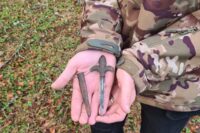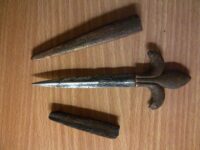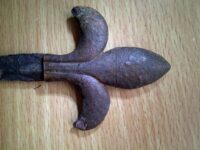 A metal detectorist has discovered an unusual medieval knife in the woods near Penicuik, Midlothian, Scotland. Craig Johnstone theorized that survivors of the Battle of Rullion Green in 1666 had escaped through Deanburn woods and was hoping to find archaeological evidence of it when he came across the much earlier and more precious object. The knife was caked in mud so it looked like a tapered piece of metal topped with a fleur-de-lis. Johnstone thought it might be the top of an iron railing that had broken off.
A metal detectorist has discovered an unusual medieval knife in the woods near Penicuik, Midlothian, Scotland. Craig Johnstone theorized that survivors of the Battle of Rullion Green in 1666 had escaped through Deanburn woods and was hoping to find archaeological evidence of it when he came across the much earlier and more precious object. The knife was caked in mud so it looked like a tapered piece of metal topped with a fleur-de-lis. Johnstone thought it might be the top of an iron railing that had broken off.
A friend on the Midlothian council showed it to the council archaeologist and she recognized it as a knife. She recommended (and this sounds a little crazy to me) that they heat it up in an oven at a low temperature with the door open. The heated blade pulled easily out of the sheath along with two pieces of leather that protected the knife from wear in the scabbard.
 With a blade only three inches long, the knife is a Skean-Dhu, meaning black or hidden knife in Gaelic. They were concealed carry weapons for noblemen, basically, so small they could be easily hidden in sleeves and waistbands. It is a high-quality blade with a hollow grind (a very sharp beveled cutting edge like a straight razor). The fleur-de-lis handle is bronze which may have originally been gilded.
With a blade only three inches long, the knife is a Skean-Dhu, meaning black or hidden knife in Gaelic. They were concealed carry weapons for noblemen, basically, so small they could be easily hidden in sleeves and waistbands. It is a high-quality blade with a hollow grind (a very sharp beveled cutting edge like a straight razor). The fleur-de-lis handle is bronze which may have originally been gilded.
The first expert to examine the knife thought it dated to the 16th century. Johnstone reported it to local Treasure Trove authorities who at first dismissed it as “relatively modern.” Only after Johnstone had the object radiocarbon dated at his own expense did he get evidence that it was far older than anybody had yet realized. The leather dates to between 1191 and 1273. Armed with this new data, he informed Treasure Trove that his knife was, in fact, relatively medieval and it will now be assessed by the Scottish Archaeological Finds Allocation Panel.
A Treasure Trove spokeswoman said: “This is a highly unusual object, comprising of a blade with a hilt and a metal scabbard with leather inside. While the leather and blade date from the medieval period, the hilt and scabbard are unusual for the period.
“Treasure Trove are still carrying out investigations into the object. It was due to be x-rayed as part of the investigation process, but this has unfortunately been delayed due to Covid-19 restrictions.”
 I’m guessing the fleur-de-lis handle was a later modification. Scotland’s association with the fleur-de-lis goes back to its alliance with France against England in the Hundred Years’ War. When this blade was crafted at the end of the 12th or early 13th century, the French monarchy had only begun to use the fleur-de-lis as a symbol of divine right rule. It wasn’t even on the Arms of France until the 1220s, although it does make an appearance on the seal of the future king Louis VIII in 1211.
I’m guessing the fleur-de-lis handle was a later modification. Scotland’s association with the fleur-de-lis goes back to its alliance with France against England in the Hundred Years’ War. When this blade was crafted at the end of the 12th or early 13th century, the French monarchy had only begun to use the fleur-de-lis as a symbol of divine right rule. It wasn’t even on the Arms of France until the 1220s, although it does make an appearance on the seal of the future king Louis VIII in 1211.